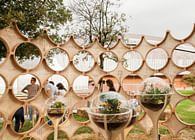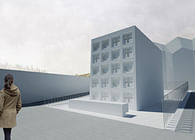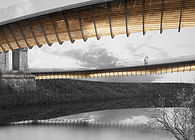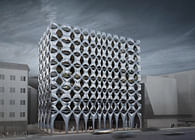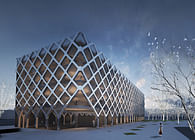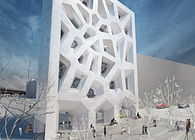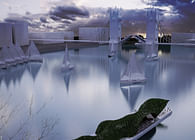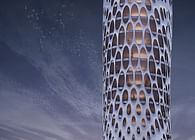
Rome, IT
The project for the new Redemptoris Mater parish complex of Cinisi (PA) was conceived as a little campus of religious faith. It is a singular entity of comfortably inhabitable spaces intimately related to each other. The strong spiritual impact of the complex arises from its dialog with its historical, artistic, and social context, and from the holistic deployment of architecture with fundamental building practices for people of today - as it does in the synergy between music and biology, between agriculture and sociology, and between psychology and religion.
The result is a parish complex that stirs the emotions in order to regenerate the spirit of the faithful, citizens of the community-at-large, and visiting guests thanks to the dynamic spaces of varying vertical relationships, organized “symphonically” to assemble a self-sufficient village, experienced daily by today’s community, steadfast and extroverted, looking to the future with the certainty of God.
The project is genetically related to its context.
It is in fact the result of a series of art-historical and formal references, resulting directly from an essay transposing into modern register characteristics connected to location and anthropology, permitting the entire parish complex to identify itself as a suitable contemporary prototype of the Sicilian architectonic tradition. The undisputed star of the new parish is undoubtedly the new church, designed and calibrated to accommodate the faithful in a simple, but highly dynamic space.
The church is deliberately oriented to the east and is a place to perceive in a concrete way the significance of redemption - through Mary, Mother of God - by virtue of an experience that involves all the human senses.
The church, the very "daughter" of the Cathedral of Monreale, reinterprets in a contemporary way some of the characteristics of the Cathedral. The profile of the pointed arch, which frames the great embrace of the Christ Pantocrator of the Cathedral, becomes the generative module constituting the structural envelope of the new church. In direct numerological reference to the Twelve Apostles and to Jesus the Redeemer, and playing with scale reminiscent of the profile of Monte Pecoraro nearby, the thirteen domes conglomerate to form a new and unprecedented landmark.
The external coloration of the the complex is inspired by the local tonnare, in particular the Tonnara dell’Orsa, visibly borrowing its tripartite volumetric organization, while the internal decoration of the domes is dominated by "l'azuolo", a shade of sea blue typical of old houses in Cinisi, which will recall the mantle of Mary and therefore her role as protectress.
The decorative embellishment of the cupolas, then, will draw on the ancient weaving pattern of Sicilian needlework, in particular the local bobbin lace. Lastly, panels of stained glass adorn the various apertures of the dome.
The community is also directly involved in the final stage realization of the design, invited to participate in the decorative program and color of the main facades through a project specially designed for this complex, an initiative called "The stones of Cinisi".
In addition to meeting all the requirements directly related to the primary use of the complex, the project hopes to become an iconic landmark and tourist attraction.
Its potential as a tourist attraction is linked to the desire to establish an emphatic relationship between the parish complex, its parishioners, and its future users.
The whole complex is thoroughly infused with references to the architectonic tradition of Sicily and its northwestern area, legibly accessible throughout the spaces and corners of the complex: from the great domes of the main sanctuary to the wooden dropped ceiling of the weekday chapel articulated by interwoven arches; from the arches of all shapes in liturgical spaces that brush against each other in order to frame the mountain, to the carved arches of the parish hall, and finally to the architecture of the photovoltaic sheds and air vents of the earthen pipe that exploit natural air movement. It is not only a solution driven by economy, but a solution inspired by the ancient and simple technology of the wind towers introduced in western Sicily by the Arabs in the 900s (10th century).
Structural analysis
Architectonically, the church is composed of 13 cupolas of varying diameter and height, which together define a rectangular space devoid of columns, combining the expression of a coffered ceiling with that of a vaulted space, a fresh architectonic typology we have dubbed “cupolinated ceiling.” Even the bell tower and the baptistery are each covered by their own cupolas. Structurally, it was decided to use the walls in concrete organized along the perimeter of the building as the primary vertical and horizontal support.
Climate control and energy strategies
The environmental comfort of the entire complex is guaranteed by the strategic air movement generated by the open spaces (the gardens), by the geometry of the cupolas and vaults, and the breeze coming from the tunnels within the project. The gardens function as storage for the cooler air, thanks to the shade provided by the building mass and strategic replanting of the existing vegetation. All the buildings are to be designed as net-zero energy structures.
Lighting study
A key aspect of this project is its integrated organization in which environmental, mechanical, electrical, lighting, and sound systems are calibrated in synergy with each other to establish the most optimal solution that guarantees energy economy, aesthetic expression, and the quality of the indoor environment. The proposed lighting scheme is developed in concert with climate analysis and facade studies with particular attention towards apertures, the air conditioning system, and the architectonics of the project as a whole.
Acoustic comfort
In order to optimize acoustic parameters to meet the needs of speech, liturgical chants, and music, as well as obtain clear sounds without reverberations, a simulation was carried out through a computer software designed to simulate the physics of acoustic propagation, including sound diffraction around the envelope, as well as transmittance through the walls (insulation against airborne noise). To optimize the various acoustic parameters required in response to the specific geometry of the space, it was decided to intervene by covering the domes and walls with smoothed sound-absorbent plaster with 35mm acoustic mineral wool, added on the dome surfaces. 3D computer simulation showed that this can obtain optimal results without sacrificing economy or compromising the architecture.
Status: Unbuilt
Location: Cinisi, IT
Additional Credits: SECOND PRIZE OF AN INVITED COMPETITION IN TWO PHASES
General information
Client Arcidiocesi of Monreale and Conferenza Episcopale Italiana
Area 9000 sqm
Location Cinisi (PA) - Italy
Year 2015
Status Second place, national invited competition in two phases
Web www.oflstudio.com/works/memoria
Video www.vimeo.com/oflarchitecture/memoria
Credits architecture
Architecture and concept Francesco Lipari
Liturgist Suor M. Cristina Cruciani
Artist Cesare Inzerillo
Team Eleonora Menichelli, Luca Bullaro, Vanessa Todaro, Gabriel Belli,
Sebastian Di Guardo, Marzia Messina, Ilja Burchard, Joshua Mackley, Elif Tan, Ludmilla Cohen
Engineering DOF Engineering
Energetic strategies Fabrizio Pizziconi
Lightning studies Giorgio Butturini
Acustic Giancarlo Bianchi
Ceramic project “Le Pietre di Cinisi” Ceramiche Bevilacqua
Artistic glass project Gianni Lucchesi
Maquette Lucchetti srl
3D optimization Arturo Tedeschi
Formwork Peri Marco Tramajoni
Concrete Italcementi Luciano Padalino
Credits presentation video
Direction and script Francesco Lipari
Narrator Carla Carta
Original music Gabriele Giambertone
Motion graphic Lucio Coppa
Animations Joshua Mackley
Environmental and drone shooting Riccio Blu
Cutting Andrea Pilia

